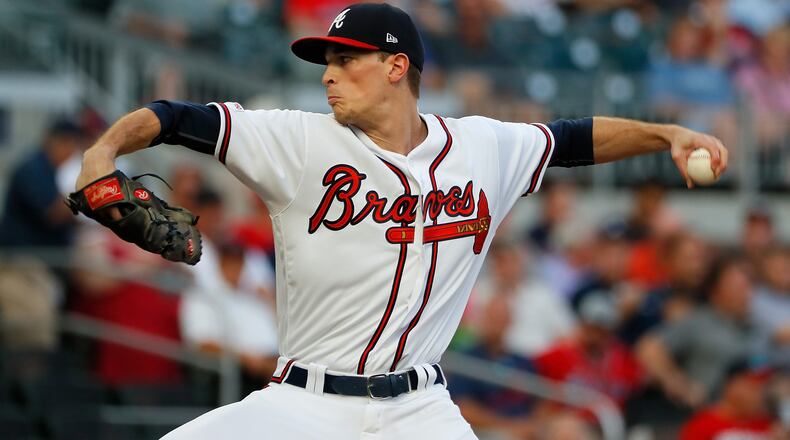Watching Mike Foltynewicz shut down the Phillies on Tuesday night made me think back to the worries about Braves pitching at the start of the season. The plan was to get by until No. 1 starter Foltynewicz and No. 2 Kevin Gausman returned from injuries. Gausman plays for the Reds now and "Folty" probably won't be among the top four postseason starters after he was No. 1 in last year's National League Division Series.
Braves pitching has come a long way. They didn’t have enough of it to deal with the Dodgers in the 2018 NLDS. They lacked quality pitching for a big chunk of this season. Now they have enough of it to take on all comers.
Braves starters ranked 11th in Wins Above Replacement among NL teams before the All-Star break. They began Tuesday ranked No. 5 in WAR since the break. That was before Foltynewicz limited Philadelphia to one run over seven innings.
The improved pitching is coming just in time: Game 1 of the NLDS is about three weeks from now. It’s starting to look like it will be Cardinals-Braves. St. Louis began Wednesday with a a four-game lead over the Cubs, who still can’t escape injuries to key players. We know the Braves can hit, even with fill-ins. They’ve developed enough pitching to handle the Cardinals, who have lots of good arms but not much offense.
Before Wednesday’s games the Braves had three starters among the top 20 in the NL for WAR since the All-Star break: Max Fried, Mike Soroka and Julio Teheran. Only the Cardinals have as many in the top 20. The Cubs, Nationals and Dodgers had two.
Fried, Soroka and Teheran have combined for 3.9 WAR in the second half. That’s the third-highest for a trio among NL contenders, behind St. Louis and Washington. Foltynewicz and Dallas Keuchel also have found good form lately.
For long stretches of the season the Braves barely had two reliable starters. They have at least three now, which is the bare minimum necessary for the postseason. Really you need four effective starters in October. It’s reasonable to believe the Braves have that now.
The NLDS is best-of-five. The Game 1 starter isn’t available for Game 4 unless he went short in Game 1. That’s where the fourth guy becomes important. A seven-game series in the later rounds usually means three starters will get two turns, with a fourth pitching in the middle.
Matchups will influence how Braves manager Brian Snitker sets his postseason rotation. That said, my preferred order for the NLDS is Soroka, Keuchel, Teheran and Fried. One reason I like this rotation is because it sandwiches two veterans between talented young guys.
Soroka has been the best Braves’ starter all season. If Game 1 goes bad for the Braves, then Keuchel is the pitcher to calm things down: he’s produced a 3.31 ERA in 10 postseason games. Teheran hasn’t been this good since he was an All-Star. Starting a deciding game would be a big spot for Fried, but he looks up to it.
Leading with Soroka might seem risky, but he’s no ordinary rookie. His even demeanor is a strength. Soroka has had shoulder issues the past two years, and he’s up to a career-high 168 innings between the Braves and Gwinnett. The Braves could ease off him once they hit their magic number to win the NL East, which stood at 10 after they beat the Phillies on Tuesday.
Kuechel is peaking. His home run rate has stabilized, and that really was the only thing holding him back. Keuchel has thrown sliders a bit more often over the past five starts, and they've been sharp. His sinker is as lively as ever and batters are making weak contact against his change-up.
It took a while for doubters to accept that Teheran’s resurgent year is real. There’s probably still are skeptics, but he’s drastically reduced his home run rate while inducing a lot of swings and misses with his slider. Hitters are doing little against Teheran’s sinker.
Even as Fried’s results fluctuated, I thought he’d figure it out because his strikeouts and walks rates kept improving. FanGraphs writer Tony Wolfe notes that Fried has added a good slider to go along with his nasty curveball. Now he’s allowing the lowest percentage of “barreled” balls (hit hard at optimal angles) among MLB starters, according to StatCast.
The Braves have a solid postseason rotation with Soroka, Keuchel, Teheran and Fried. Their bullpen depth isn’t great. Trade deadline additions Mark Melancon, Chris Martin and Shane Greene have settled into the back end. It can be volatile after those three. Maybe “Folty” can help in the ’pen now that he’s been effective in seven starts since returning from Triple-A.
Relief pitching may end up being a weakness for the Braves in October. They don’t want to go too deep in the ’pen. But every NL team has flaws. Even the Dodgers have been mortal lately as their seemingly unassailable starting pitching has slipped.
Braves starters are tending the other way. The Braves have four reliable guys for October. That’s enough for them to make a serious bid for the NL pennant this time.
About the Author
The Latest
Featured


